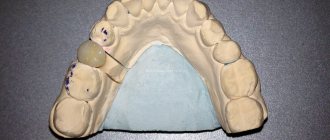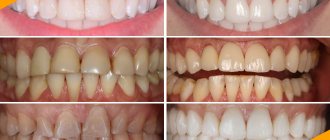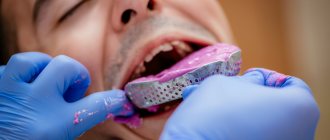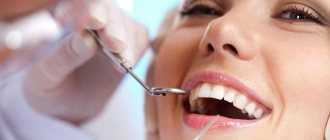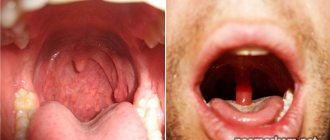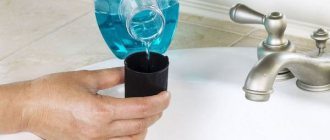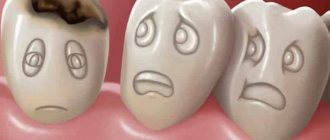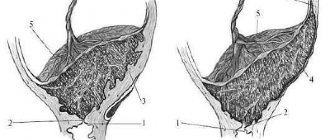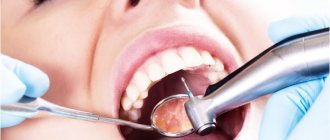398
Ceramics was initially the material whose aesthetic properties best met the needs of dentists.
Only insufficient strength prevented it from taking a leading position in orthopedic dentistry.
Today there are a large number of brands of dental ceramics that can withstand any chewing load.
History of appearance
The history of dental ceramics goes back more than 200 years. The first researchers to study the possibility of using porcelain as teeth and to leave their mark on the documents were the Frenchman Alexis Duchateau and the Italian Nicholas De Chemant.
In 1774, they tried to make artificial teeth from traditional green porcelain.
The first dental ceramics that vaguely resembled natural teeth in color was produced by Elias Wildman. This happened in 1838.
Properties of dental porcelain
Porcelain is a brittle material with little ductility. The compressive strength is approximately 170 MPa. bending strength is 50-75 MPa and tensile strength is about 25 MPa. The values of other physical properties include an elastic modulus of 69-70 GPa (enamel - 46 GPa), a linear coefficient of thermal expansion (12-14) x 10 * 6 / ° C, similar to the coefficient of tooth structure, and a surface hardness of 460 KHN (versus 344 KHN at enamel).
Also read: Restoration of anterior teeth: main methods and cost
Composition and properties of the material
The vast majority of ceramic systems consist of an amorphous matrix and a crystalline filler uniformly distributed within it. There are so many types of dental ceramics that it is impossible to examine and understand them without first differentiating them based on some characteristics.
The material can be classified as follows.
By matrix type:
- Feldspathic glass.
- Lanthanum glass (lanthanum in its pure form is a silvery-white, malleable and malleable metal).
- Polymers.
Organic plastics are part of the so-called hybrid ceramics, which have recently appeared in the range of some manufacturers of dental materials. Currently, they are being tested; a final conclusion about the advantages and disadvantages of hybrid ceramics has not yet been made. - No matrix at all. This type includes a material consisting almost 100% of aluminum oxide crystals sintered together.
By filler:
- quartz;
- leucite;
- alumina-magnesia spinel;
- and other fillers, which are discussed below.
According to manufacturing technology, ceramics can be:
- sintered;
- cast;
- pressed.
- infiltrated.
The basis of porcelain for use in dentistry is ceramics, consisting of elements such as quartz (silicon oxide - SiO2) and feldspar (a mixture of sodium aluminosilicate (Na2O Al2O3 6SiO2) and potassium silicoaluminate (K2O Al2O3 6SiO2)).
Such ceramics are called “feldspathic”. Unlike porcelain used in everyday life, it does not contain kaolin, which, due to its opacity, does not allow obtaining a shade identical to the color of natural teeth.
What complications may arise after dental prosthetics and their treatment tactics.
Come here to find out if dentures are possible for periodontal disease.
At this address https://www.vash-dentist.ru/protezirovanie/nesemnyie-p/koronki-np/osobennosti-vosstanovleniya-polu.html we will consider the principle of making half-crowns.
The role of feldspathic material
The disadvantage of feldspathic ceramics is their high fragility. The tendency to form cracks does not allow obtaining a bending strength of more than 40-60 MPa.
For a long time, the goal of dental researchers has been to increase the strength of feldspathic ceramics by changing its structure, adding strengthening fillers and improving firing technology.
The first positive results were obtained by reducing the size of quartz particles and evenly distributing them over a glass matrix.
Together with the use of vacuum furnaces, which reduced the porosity of the ceramic mass, this made it possible to obtain feldspathic material with a bending strength of up to 150 MPa. But this still was not enough.
If the frontal teeth, made of porcelain with a strength of 150 MPa, coped with their functions for a relatively long time, then the dentures installed on the lateral teeth or those that were of greater length could not withstand the chewing load.
Real success was achieved by placing other compounds, mainly oxides, into the glass matrix as fillers. Distributed evenly over the feldspathic glass, the filler crystals prevented the propagation of cracks in it, making the material much stronger.
As a result, a large number of durable and technologically advanced materials have been developed, united under the general name “dental ceramics”.
The following compounds are used as fillers.
- Fluorapatite (Ca10(PO4)6(F)2). The addition of fluorides made it possible to achieve a strength of 120-150 MPa.
- Leucite (KalSiO6). Ceramics with a small content of leucite have a flexural strength of about 150 MPa. Increasing the potassium oxide content to 50% made it possible to obtain a material with a strength of 200 MPa.
- Magnesium and aluminum oxides (MgAl2O4, alumina-magnesia spinel). Feldspathic ceramics reinforced with spinel have a strength of up to 350 MPa. Its peculiarity is that, unlike other types of hardened ceramics, it has very good aesthetics.
- Lithium apatite disilicate (Li2Si2O5, SiO2-Li2O-SiO2). The filler allows you to increase the strength of the material up to 450 MPa.
- Aluminum oxides (Al2O3) increased the strength to 450 MPa.
- Zirconium oxide (ZrO2). Its addition made it possible to increase the flexural strength of ceramics to 650-700 MPa.
In addition to strengthening fillers, the ceramics contain dyes:
- iron oxide (brown);
- copper (green);
- cobalt (blue);
- titanium (brown-yellow).
Organic additives (starch + sugar) make the ceramic mass plastic, making it easier to work with.
It should be noted that increasing the strength of the material sometimes conflicts with aesthetic parameters. Feldspathic ceramics have the greatest aesthetics.
The addition of most fillers impairs transparency, thereby reducing the aesthetics of the artificial tooth. Therefore, many types of reinforced material are used as a frame for prostheses.
By covering it with transparent feldspathic ceramics, a color effect is obtained that is extremely similar to the enamel of natural teeth.
Group CL-I (powder/liquid)
These types of ceramics in dentistry consist of powdery and liquid materials. Their main component is silicon dioxide, which is contained in the glassy mass. Depending on the ratio of these components, the crown will have a more or less pronounced crystalline structure.
The CL-I group includes:
- Creation Porcelain, Jensen Dental;
- Ceramco 3, DENTSPLY International;
- EX-3, Kuraray Noritake Dental, Inc.
Dentures can also be made from feldspar, which contains barium, potassium, calcium or sodium. Initially, dental crowns were made from this material.
Options for aluminosilicates used:
- VITA VM 13, VITA Zahnfabrik;
- Vintage Halo, Shofu.
The production of prostheses of the CL-I group is carried out manually. They are used primarily for restorations that preserve most of the tooth, since the material is quite fragile and transparent. Nevertheless, it is feldspars that make it possible to achieve the best results when correcting the structure of a damaged crown.
Aluminosilicates are applied to the enamel in a thin layer of 0.2−0.3 mm. As a rule, ceramics from the CL-I group are used to restore incisors and canines, and less commonly, molars and premolars. Although the ceramic mass used for teeth is quite fragile, under adequate load the probability of its damage is very low.
Receiving technology
Powder obtained from ceramic mass using a special technology is used as blanks for creating prostheses .
The mixture is fritted (primary firing). The resulting product is called “frit” and is a fine-crystalline dispersion of quartz with fillers.
Due to the rapid cooling, the frit has many cracks that allow it to be ground into a fine powder. Fritting also promotes uniform distribution of components throughout the material.
Ceramic mass, which serves as the starting material for the manufacture of prostheses in laboratory and factory conditions, exists in the following forms.
- Powder made from frit. It is used by dental technicians in laboratory conditions (mixed with water), as well as in factories for the production of dentures. This form of the original ceramics is called conditioned.
- Tablets compressed from powder. They are used in particular for the manufacture of crowns using the injection molding method.
- Solid machine blocks. The term “machine” means that these blocks are designed for cutting crowns and inlays using special milling equipment using CAD/CAM technology.
- Infiltrated ceramics. It consists of a powder filler and an amorphous lanthanum glass matrix.
The video shows the process of casting and pressing ceramics.
What makes e.max metal-free ceramics unique?
Metal-free ceramics are produced and consist of 70% lithium disilicate crystals, so the material also has a second name - glass ceramics.
The use of material in the manufacture of dentures allows you to obtain the most aesthetic result of dental restoration. Crowns and veneers made from e.max cannot be visually distinguished from natural teeth, since the material has light transmission similar to natural enamel and has a wide range of shades.
Glass ceramics e.max can be the optimal solution if it is necessary to restore teeth included in the smile zone when carrying out aesthetic restoration of teeth with veneers. This material can be recommended for prosthetics for those patients who are demanding in terms of aesthetics. A new smile with e.max crowns will be impeccably beautiful!
Varieties
Ceramics can be present in the prosthesis in the form of metal ceramics (the material is applied to a metal base) and all-ceramic structures.
Metal ceramics have been successfully used by dentists for a long time. All-ceramic prostheses have proven their viability only since the 80-90s of the last century.
All-ceramic designs
Until the end of the last century, the use of all-ceramic structures was complicated by the fragility, cracking and high abrasiveness (abrasion of antagonist teeth) of the material.
A breakthrough occurred when technologies for making hardened porcelain and high-quality fixation cements were developed, with which the prosthesis was attached to the tooth.
An important factor in the manufacture of all-ceramic structures is the high precision of their manufacture, which allows the crown or inlay to be securely attached to the tooth.
All-ceramic structures exist in the form of crowns, inlays, veneers and not very long (no more than 3 teeth) bridge prostheses.
Initially, the technology for manufacturing all-metal structures involved laying and firing (sintering) a powdered aqueous suspension on platinum foil placed on a tooth model.
Today, other methods for producing all-ceramic dentures are used.
Why is the crown on the implant loose, and what to do in such a situation.
In this publication, we will find out whether there is an allergy to a metal-ceramic crown.
Here https://www.vash-dentist.ru/protezirovanie/nesemnyie-p/sostavnyie-mostovidnyie-vozmozhnost.html read about composite bridges.
Sintered glass crystals
Sintering is a process of treating a porous ceramic mass at high temperatures (over 1000 °C), resulting in the material being compacted and strengthened to levels that can withstand chewing loads.
The technology consists of layer-by-layer application of a powder suspension onto the prosthesis form, and subsequent firing in a vacuum (to reduce pores) oven. As a result of firing, the ceramic mass is melted and a prosthesis is formed from it.
At first, firing was carried out on platinum foil covering the mold, which greatly increased the cost of the final product. With the advent of refractory molds made from phosphate compounds that can withstand high temperatures, it became possible to eliminate expensive platinum foil.
Using sintering, it is possible to obtain various all-ceramic prosthetic structures - crowns, veneers, bridges. The technology provides good aesthetic parameters. Artificial teeth have an opalescent effect, which is inherent in natural teeth.
Cast ceramics
It is a complex technology best known under the Dicor brand. Allows you to obtain an aesthetic, well-polished product with a complete absence of pores.
Casting using a centrifuge (centrifugal casting) is carried out in a refractory mold with wax melting. The material is most often available in one color.
Standard feldspathic ceramics or painting are used as cladding. Due to its complexity, the technology has not been widely adopted.
Pressed ceramics
This technology is a type of casting. The starting material for it is tablets (ingots) pressed from powder.
The most famous is the pressed ceramics IFS EMPRESS from Ivoclar.
The technology consists of several stages - taking an impression, wax modeling of the prosthesis, placing the model in a refractory phosphate mold, melting the ceramic mass and pressing it into the cavity formed after the evaporation of the wax.
Advantages and disadvantages
Ceramic veneers are a special group of orthopedic devices that have significant advantages over other restoration methods:
- Highest aesthetics. Due to their good light conductivity, the color of the veneers perfectly matches the color shade of natural enamel.
No other dental material can match high-quality ceramics in its ability to imitate the shape and color of natural teeth. Beautiful snow-white veneers create the effect of lifting the lower part of the face without plastic surgery. - Durability. The appearance and strength properties of ceramic veneers, provided they are used correctly, are preserved for a very long time.
- Full biocompatibility with dental tissues.
- Minimal grinding of enamel due to the thinness of the overlays.
- Correction of some dental defects (in particular, small irregularities) without the use of braces.
- Reduced tooth sensitivity.
Disadvantages of veneers:
- Irreversibility of restoration. Since the installation of veneers involves grinding down the teeth, it is no longer possible to refuse to wear them.
- The complexity and high cost of the work , the need for special equipment, high demands on the professionalism of the doctor.
- Not all teeth can be restored with veneers. Their translucency (light permeability) can be an obstacle to use on teeth that are too dark (“darkness” will show through a thin overlay).
- Installation on chewing teeth is undesirable (although some types of products can also be installed on the lateral row).
Getting to know Cerec
The CEREC system was developed by the Swiss company Dentsply Sirona. The abbreviation CEREC - “Chairside Economical Restorations of Esthetic Ceramic” can be roughly translated as “economical restoration using aesthetic ceramics directly at the patient’s chair.”
The method is an innovative technology for prosthetics using cutting (milling) of a prosthetic structure (inlays, crowns) from ready-made ceramic blocks.
That is, it is nothing more than a CAD/CAM system. Its essence is that prosthetics are performed in one visit. Modeling and manufacturing of the prosthesis is carried out in the presence of the patient (Chairside - next to the chair).
Blocks of feldspathic, lithium disilicate or leucite ceramics are used as blanks for the manufacture of crowns and inlays.
Stages of prosthetics include:
- removing plaque and plaque from teeth;
- tooth preparation (preparing a cavity for an inlay or tooth stump for a crown);
- scanning the prepared tooth and the adjacent space (including antagonist teeth) using a special intraoral video camera to obtain a three-dimensional image of the prosthetic tooth;
- modeling of a prosthesis using a three-dimensional image;
- choosing a suitable ceramic block (selection is made by size and color);
- processing of the workpiece on a special milling and grinding machine connected to a computer (all processing parameters are set by a computer program);
- installation of a prosthesis on a tooth - fitting, finishing, etching, applying ionomer cement or composite, fixing, grinding to ensure normal occlusion.
One of the main advantages of CAD/CAM technology is the speed and accuracy of prosthetics.
It takes up to 1.5 hours to manufacture and install a 3-tooth bridge. In this case, the dimensional error does not exceed 40-50 microns.
CL-III (high strength crystalline materials)
The peculiarity of this group is the content of a small amount of crystals in the material or their complete absence. Manufactured industrially. The main difference from previous types of ceramics is the formation of a certain connection between the main matrix and the crystals. Classified into two types:
- CL-IIIa. The manufacturing principle is to form a porous block, which is filled with a molten phase (lanthanum aluminosilicate glass). This liquid fraction fills all the pores, as a result of which significant strength of the ceramic is achieved. Despite this advantage, such prostheses began to be used less and less, and they were replaced by 100% polycrystalline ceramics (group CL-IIIb).
- CL-IIIb. Crowns are made from polycrystalline ceramics, which consists of aluminum oxide. Recently, preference has been given to products made from zirconium dioxide. It is used for prosthetics of single teeth, bridges, or in cases where bonding is quite difficult.
To ensure high quality fixation of crowns, it is recommended to use materials of group CL-III or CL-IV (metal-ceramics). This is because the fabricated structures can be secured using a direct protocol. But in the case when zirconium material is used as a prosthesis, special attention should be paid to the interaction with the teeth of the opposite jaw.
High-strength crystalline materials should be applied with a thickness of 1.2–1.5 mm. It depends on the required shade. Products made from CL-III group compounds are an alternative to metal ceramics.
Reviews
Dental ceramics are distinguished by their excellent appearance. However, acquiring perfect dentures cannot be considered a cheap pleasure, so their service life is of great interest to users.
If, from personal experience, you can satisfy this curiosity to some extent, please leave a comment at the bottom of this page.
If you find an error, please select a piece of text and press Ctrl+Enter.
Tags fixed prosthetics prosthetics
Did you like the article? stay tuned
Previous article
Is it possible to replace lost teeth in children using implantation?
Next article
When bite defects can be corrected using partial braces
Classification of ceramics by level of transparency
The level of transparency of dental ceramics is indicated in Latin letters:
- HT (High Translucency) – high transparency;
- LT (Low Translucency) – low transparency;
- MO (Medium Opacity) – medium opacity;
- HO (High Opacity) – high opacity.
These four levels are typical only for glass ceramics. Oxide ceramics only meet the HO level. Zirconium oxide belongs to the MO level and does not correspond to the specified HT. The higher level of transparency of zirconium oxide is explained by a decrease in the porosity of the material. Less porous - scatters light less, acquires transparency and higher strength.
The choice of ceramics with a particular transparency depends on the type of denture and the color of the supporting tooth. Highly transparent ceramics are suitable for partial restorations and are not suitable for crowns due to the prospect of translucency of the dark oral cavity. Monolithic dentures are recommended to be made from HT and LT ceramics. To completely or partially cover the shade of the prepared tooth, HO and MO are used.
Indications and contraindications
The technology for installing veneers allows their use in the presence of the following medical indications:
- The presence of obvious defects in the incisors - irregularities, chips and cracks, abrasion of the enamel;
- Excessive thinness or change in the natural shade of the enamel layer;
- A gummy smile, to eliminate which complex treatment is used, including plastic changes to the gums;
- Increased temperature sensitivity of teeth;
- The need to eliminate diastemas and increase the visual appeal of the smile.
Possible contraindications include:
- Critical thinning of enamel;
- The presence of extensive damage caused by caries;
- Large chip area;
- Periodontal diseases;
- Bruxism and incomplete teething;
- Previously installed massive fillings.
In the presence of dental pathologies, preliminary treatment is carried out, based on the results of which a decision is made on the possibility of installing veneers.
The difference between EMAX veneers and feldspathic veneers. What's the difference and which are better?
When we talk about ceramic veneers, this term refers to 2 main types of ceramic veneers:
- Emax or pressed veneers, they are also called press ceramic veneers;
- Feldspathic veneers;
EMAX veneers
EMAX veneers are veneers that are made by cutting a veneer from a blank.
To make this type of veneers, square blocks of ceramic are cast, one specific standard color throughout the entire thickness, for example, A1. This is a significant drawback, since the entire thickness of the veneer is one color.
When we look at such veneers in a patient’s mouth, for example, when smiling, teeth that are not naturally uniform in structure are immediately noticeable.
Unfortunately, in practice, the patient is not always satisfied with the aesthetics of the smile when using EMAX veneers, because if we look at the smile of a person with natural healthy teeth, we will see that a healthy tooth has a huge number of shades that manifest themselves not only during the day, but also during night light. Each person is individual, and everyone’s smile is also individual. If you look at your smile in the mirror, you will notice that closer to the gum at the base, the tooth has a more yellowish tint, at the incisal edge the tooth is more transparent or has a matte tint, and each individual tooth has its own special structure.
Emax veneers
Figure showing the monochromatic color of veneer A1 using Emax technology
Advantages and disadvantages of EMAX veneers.
The advantages include the cost, which is usually lower than the cost of feldspathic veneers, and the speed of production (1-2 days). Among the disadvantages, it is worth noting that the teeth are unnatural, the teeth are the same color and it will be immediately clear to anyone that your teeth are “not real.”
Feldspathic veneers.
Feldspar veneers are a layer-by-layer application of ceramics by hand by a dental technician, which is a highly artistic and precise work that requires extensive experience to achieve maximum color rendition.
The technician manually sequentially applies layers of ceramic to the future veneer, the thickness of which is a fraction of a millimeter.
When applying, the technician takes into account the anthropometric initial data of the patient (description of the dentist, photographs of the pronunciation of certain sounds, photographs of sitting and standing, photographs in different lighting).
All photographs are extremely important in order to see the overall picture of the patient’s teeth and smile line, as well as to plan the ideal shape of future veneers.
Feldspathic veneers are the product of an accurate and harmonious reproduction of a natural smile and this work can be confidently equated to art. Not every dentist will be able to distinguish a feldspathic veneer from a natural tooth.
Feldspar veneers
Advantages and disadvantages of feldspathic veneers
Among the advantages, one can immediately highlight 100% naturalness, which leaves no chance of understanding the patient’s natural teeth or veneers.
The disadvantages include a slightly increased production time (on average 1.5-2 weeks), due to the thorough reproduction of all visual features of the patient’s teeth.
The cost of feldspathic veneers is slightly higher, however, at the moment, Estet Dentistry installs such veneers at a more affordable price than other clinics that install mainly EMAX veneers. Due to regular promotional offers, please check the current price by phone!
Currently in Perm, only a few clinics provide services for the manufacture and installation of feldspathic veneers. The Estet Clinic is the first clinic in Perm to introduce this highly artistic and high-quality method of dental veneering. By contacting us, you receive a guarantee of a flawless smile that will delight you and everyone around you with its aesthetics and perfection.
The picture shows what a feldspathic veneer looks like, recreated from a prototype of a healthy human tooth.
Now in detail for each point
The value of -50 microns is achieved empirically and is dictated by the following factors. Let's take ideal conditions when there is a ready-made feldspathic restoration made by grinding or milling. You can achieve a smooth restoration by polishing with rubber bands and polishing paste, or you can coat it with a thin layer of glaze in a single glaze firing. According to VITA, the glaze layer can vary from 15 to 25 microns, and depends on the dilution of the glaze and the thickness of application. I prefer to make the contact points tighter and ground them during the fitting of the restoration rather than perform a correction firing. With a value of 0, as a rule, restorations are not installed in the seat, since there is excess material at the contact points. In this case, I sand the contact surfaces. This takes time, sometimes so long that it would be better to do a corrective firing. With a value of -50, this is already a greater risk on the verge of a gamble.
Will the contact point be tight enough or will I have to finish baking it? At a value of -25, patients sometimes note a feeling of wedging, although the floss clicks loudly when passing the contact point! After a few minutes, this sensation goes away in the patient and does not cause discomfort. Don't be afraid to make a mistake, there is a decent way out of every situation.
About the spacer. For Cerec, 60-80 is the optimal value. If it is less, then you will have to correct the crown from the inside, and this will take extra time.
Let's go back to where the value adjustment came from...
- First, when you scan with an Omnicam camera, the process is not perfect. According to Sirona, the camera accuracy is 20 microns. And if saliva gets into the area of your scanning, then the accuracy of the future 3D model drops significantly.
- Secondly, Cerec software, like other analogues, creates a 3D model based on 2D images. And at this stage there may also be permissible errors.
- Thirdly, during grinding of restorations there is vibration from rotating instruments. And, in fact, from a solid ceramic block we get a restoration, on the surface of which there are multiple chips at the micro level. These chips are perfectly filled with a layer of glaze during the glaze firing. And this is only the option with feldspathic ceramic blocks. And if you take E.max lithium silicate blocks, then after crystallization firing they undergo uncontrolled shrinkage of up to 0.4%. Yes, the software makes corrections during modeling and grinding, but the error still exists and the patient and dentist will encounter this during the fitting.
- Fourthly, the adhesive system and the cement with which you fix the restoration, namely, what density it is. PECULIARITY! You need to apply enough force to the restoration at the time of its fixation so that the excess cement comes out EXACTLY! And if your restoration is very thin, then it will burst, but if it meets the strength requirements, then it will withstand everything.
Viscous dual-curing cements come out quite difficult, and it is worth applying sufficient force, waiting until all the excess cement comes out and not releasing the restoration until the moment of fixation polymerization of 5 seconds on both sides (palatal/lingual and vestibular). A heated composite material such as ENAMEL may seem easier to some clinicians because when heated it can be more fluid than dual-cure cement. It's a matter of preference and work experience. And, of course, it is worth remembering that the layer of adhesive that you apply to the stump and to the inner surface of the all-ceramic crown also has a certain thickness.
Based on the above, errors and inaccuracies may be made at each stage. At each stage, you can reduce the errors of future stages by setting the correct parameters. A scan error of 20 µm can be made up by reducing the occlusal surface by 50 µm. And a layer of glaze will be placed on the restoration, and cement will be able to fill from the inside any possible errors made by the operator when preparing the stump.
Rice. 12, 13, 14 and 15. The result of prosthetics.

